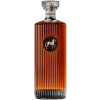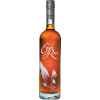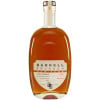About Double Barrel Scotch Whisky
Situated in the Orkney archipelago in Northern Scotland, Highland Park Distillery was founded in 1798 by Magnus Eunson. The name of the distillery is derived not from the region of Scotland known as The Highlands (the Orkney islands are not a part of The Highlands) but rather, from the area of the islands known as High Park, where the distillery was founded.
Today, over two centuries after its founding, Highland Park Distillery remains one of the few Scottish distilleries that continues to hand-turn, malt, and peat its own barley. "You have to be careful here on the malting floor," says Eric Tait, Highland Park's Maltman. "You find it can get a wee bit slippery underneath. I have to turn the malt every eight hours to prevent the roots from getting tangled and to get it all aerated properly. The airing also helps it to grow. The malt will be on the floor for seven days and I'm running five floors at the moment."
After malting the barley, Highland Park Distillery smokes it using peat sourced from Hobbister Moor, a peat bog located approximately seven miles from the distillery. Hobbister Moor peat is sourced from floral heather bushes, which burn hotter and cleaner than the grassy peats of Islay. In addition, the peat sourced from Hobbister Moor has greater derivatives of carbohydrates and a lower concentration of lignin than peat from Islay, giving Highland Park's peat a unique chemical fingerprint. The peat sourced from Hobbister Moor is "absolutely fundamental"in understanding the flavor of Highland Park Whisky, says Russell Anderson, the Distillery Manager. Together with Orkney's unique environment (the temperate, moist climate of the archipelago allows Highland Park Whisky to mature evenly), the peat gives Highland Park Whisky its traditional malty, coastal flavors tempered by just a subtle touch of smoke.
Founded in 1779 by John Simpson, Bowmore Distillery has stood on the shores of Loch Indaal, a sea loch that opens out into the Atlantic Ocean, for over two centuries. Similar to Highland Park, Bowmore is one of the few remaining distilleries in Scotland that malts its own barley before drying it over a peat flame (at Bowmore, the barley is turned every four hours). Unlike some other distilleries on Islay, however, the drying process is much shorter at Bowmore — only 15 hours — and utilizes only half as much peat, resulting in a more robust yet still mild, smoky flavor.
Bowmore draws its water from Laggan River, which flows through peat bogs on its way to the distillery and adds a unique, mineral flavor to the whisky. In addition, the distillery's location on Loch Indaal contributes not only to the whisky's salinity, but also to its smoothness and complexity.
Double Barrel Scotch Whisky is a vatting (or blending) of Highland Park Single Malt Scotch Whisky with Bowmore Single Malt Scotch Whisky. Douglas Laing, one of the most prominent independent bottlers in Scotland, married together one single cask of Highland Park Single Malt and one single cask of Bowmore Single Malt in order to produce Double Barrel Scotch Whisky. Aged for a minimum of ten years and non-chill filtered, these casks were combined to produce a whisky that has an aroma of buttery biscuits and gentle notes of cinnamon and peat. The aroma opens up to soft, textured notes of citrus and honey. The finish is gentle and spicy, with hints of toffee and chocolate.
Double Barrel Scotch Whisky earned a score of 95 points and the "Liquid Gold Award"from Jim Murray's
Whisky Bible in 2011. Pick up a bottle today!
About Scotch
Scotch is the most popular whisky in the world and is considered the king of them all! There are five whisky regions in Scotland (six if you count the not officially recognized Islands), and each of them produces spirits with unique properties and distinct tasting notes. (The type of grain used determents the type of the scotch.)
Malt whisky is made of malted barley, and grain whisky uses other grains like corn or wheat. Most of the time, a whisky is blended from different distilleries hence the name blended scotch, but if a malt whisky is produced in a single distillery, we get something extraordinary called a single malt.
Check out our impressive selection of scotch whiskies, find your new favorite in the Top 10 scotch whiskies, or explore our treasury of rare & hard to find scotch whiskies.











